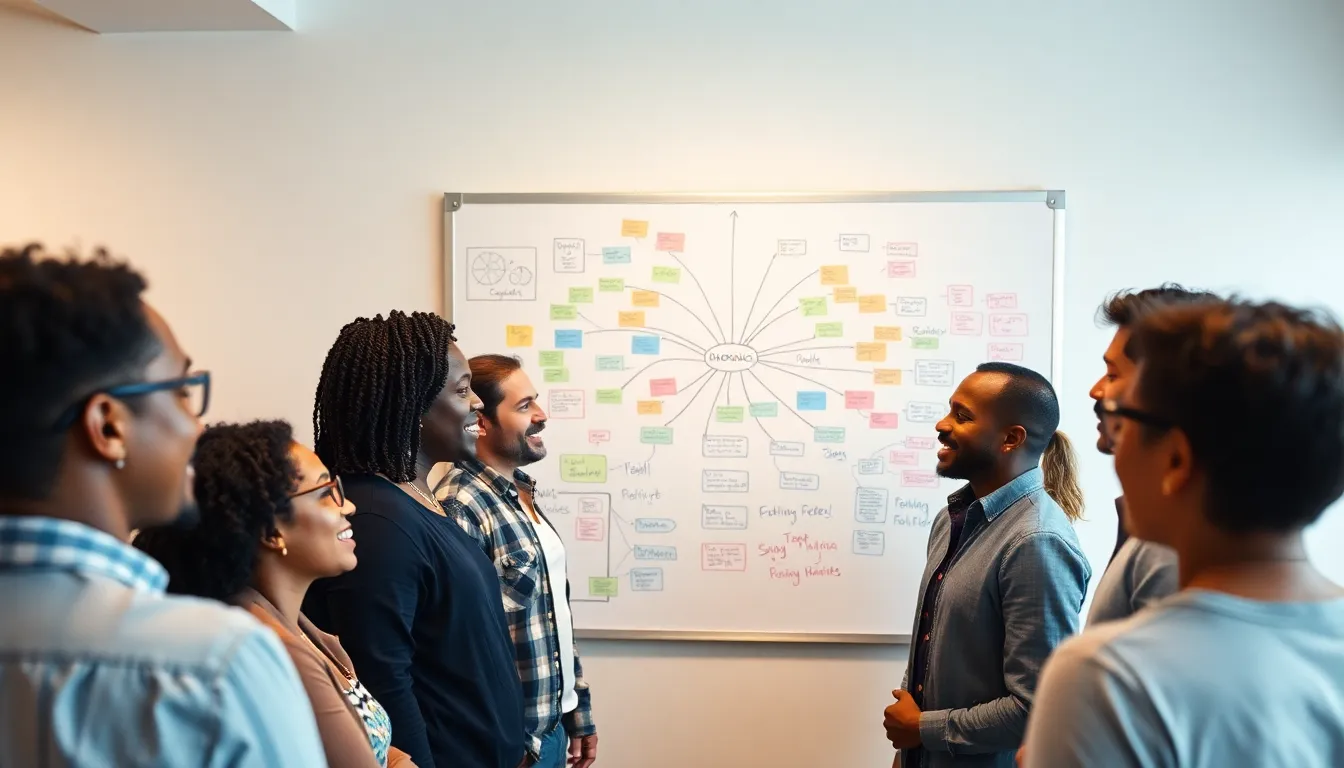Table of Contents
ToggleIn a world overflowing with ideas, finding the right path can feel like navigating a maze blindfolded. Enter the idea webbing technique—a creative powerhouse that transforms chaotic thoughts into a structured masterpiece. Think of it as your brain’s personal organizer, helping to untangle those wild ideas and connect the dots like a pro.
Overview of Idea Webbing Technique
Idea webbing serves as a visual mapping strategy for organizing thoughts. This technique allows users to create connections between various concepts, leading to a clearer understanding of the relationships among ideas. By placing a central theme at the core, they can branch out related ideas, creating a network rather than a linear list.
Using circles or boxes, individuals can represent each idea visually. Connections between these representations can establish relationships and hierarchies. This method proves beneficial for brainstorming sessions, offering insights that might remain hidden during standard note-taking.
Additionally, idea webbing enhances creativity by encouraging free thinking. It moves away from rigid structures, allowing thoughts to flow naturally. The flexibility of this technique accommodates both personal projects and group collaborations, appealing to various users.
Engaging with this method fosters an immersive experience. Participants can explore ideas in-depth, discovering new perspectives. Frequent practice can improve the effectiveness of idea webbing, making it easier for individuals to generate and refine concepts.
Ultimately, individuals seeking clarity and creativity in their thought processes should consider idea webbing. This tool not only makes chaotic thoughts manageable but also promotes innovation by encouraging diverse connections. Heightening awareness of orchestrated ideas enriches overall understanding and enhances problem-solving skills.
Benefits of Idea Webbing Technique

The idea webbing technique provides multiple advantages that enhance the thought process and creativity. Various benefits stem from its use in both individual and group settings.
Enhanced Creativity
Creativity thrives in a free-flowing environment. This technique encourages individuals to explore unconventional ideas without conventional boundaries. By visually connecting thoughts, it reveals relationships that spark new insights. Participants often discover unique solutions as they navigate through interconnected concepts. Brainstorming sessions become more dynamic when individuals can visualize their ideas collectively. Flexibility in organizing thoughts fosters a creative mindset, enabling users to approach problems from fresh perspectives. In addition, the technique promotes collaboration, allowing diverse viewpoints to merge and inspire innovative outcomes.
Improved Organization
Organization significantly improves understanding and retrieval of information. Through idea webbing, various concepts become visually structured, making complex topics easier to digest. Central themes anchor related ideas, creating a clear hierarchy for users. Each branch represents a specific thought, leading to a comprehensive view of the subject matter. This method reduces memory overload by offering a clear visual representation of connections. Review sessions become efficient as users can quickly reference the structure and locate information. Additionally, this technique helps to prioritize tasks and ideas, assisting in effective planning and execution.
How to Implement Idea Webbing Technique
Creating an idea web is straightforward and can significantly enhance thought organization. Follow a concise approach to get started.
Step-by-Step Guide
- Identify the central theme. Choose a topic or main idea that anchors your web.
- Draw a circle around the central theme. This visual representation serves as the hub of your web.
- Brainstorm related ideas. Write down all concepts that connect to the central theme.
- Connect related ideas with lines. These connections illustrate relationships between thoughts.
- Branch out with sub-ideas. Add circles for new ideas and connect them to their relevant concepts.
This simple method of visual mapping allows for an intuitive exploration of thoughts and ideas.
Tips for Effective Use
- Use colors to differentiate ideas. This visual variety enhances clarity and aids in memory retention.
- Keep the language simple. Clear and concise wording helps in quickly grasping connections between concepts.
- Review the web regularly. Revisiting your idea web encourages fresh insights and deeper understanding.
- Engage in group sessions. Collaborating with others promotes diverse viewpoints and stimulates creativity.
- Stay open to non-linear connections. Embracing unconventional links can reveal innovative perspectives.
By following these tips, individuals can maximize the potential of the idea webbing technique for personal or collaborative projects.
Common Applications of Idea Webbing Technique
The idea webbing technique finds versatile applications across various fields. This creative approach transforms the way individuals and teams organize and develop thoughts.
In Education
Educators frequently implement idea webbing to enhance student learning. Students actively engage with complex subjects, making connections between concepts. Teachers can use this technique for brainstorming lessons, encouraging exploration. Visual mapping aids retention and comprehension, creating a clear context for discussions. Students also feel encouraged to think creatively, cultivating a richer understanding of subject matter.
In Business
Businesses utilize idea webbing for project planning and strategy development. Team members collaborate effectively, generating innovative ideas during brainstorming sessions. This technique facilitates the visualization of relationships among projects, goals, and resources. Clear connections enable teams to prioritize tasks, streamline workflows, and enhance decision-making. Managers appreciate its ability to foster a creative culture that drives collaboration and enhances problem-solving capabilities.
Embracing the idea webbing technique can transform the way individuals approach their thoughts and projects. By fostering an environment that encourages creativity and exploration, it empowers users to connect ideas in meaningful ways. This visual mapping strategy not only enhances organization but also reveals insights that may otherwise remain hidden.
Whether for personal use or collaborative efforts, idea webbing offers a dynamic framework that supports innovative thinking. Regular practice of this technique can lead to improved problem-solving skills and a deeper understanding of complex topics. As individuals incorporate idea webbing into their routines, they’ll likely discover new perspectives and enhance their overall creativity.







